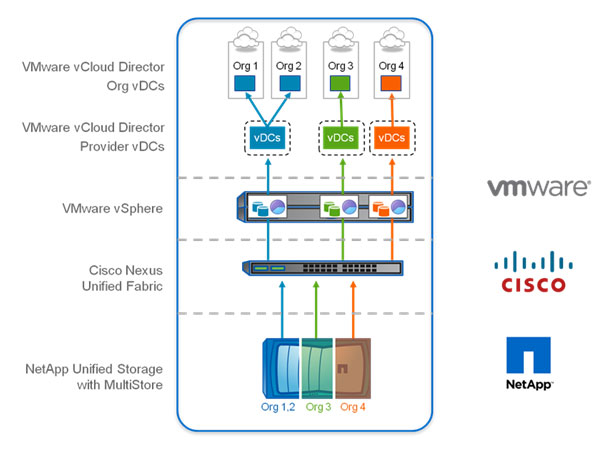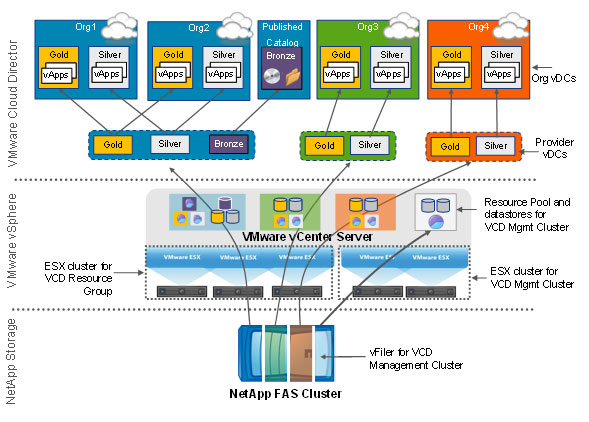Announced at VMworld 2010, VMware® vCloud Director is a key element of the VMware cloud computing approach. vCloud Director is designed to pool virtual infrastructure resources into virtual data centers and deliver them to users as catalog-based services, providing the automation and management necessary for internal and external clouds.
A vCloud environment requires efficient, highly available storage to deliver an end-to-end infrastructure optimized for cloud computing. By building upon a NetApp shared storage infrastructure, you can deploy VMware virtualization technology and make the transition to a service model based on vCloud Director while continuing to benefit from the storage efficiency, data protection, and manageability features of NetApp.
NetApp has jointly developed a solution guide with VMware that describes a reference architecture for deploying NetApp storage with vCloud Director to deliver cloud-enabling capabilities, including:
- Elastic scalability
- Secure multi-tenancy
- Rapid provisioning
- Storage efficiency
- Chargeback
- Integrated data protection and high availability
- Unified storage
This article provides an overview of vCloud Director, describes the building blocks of the reference architecture, and provides a preview of several of the planned enhancements to the NetApp vCloud solution.
Understanding VMware vCloud Director and NetApp
A high-level overview of a vCloud Director deployment using NetApp storage (per the new solution guide) is illustrated in Figure 1. Each organization has access to a self-service portal with its own virtual data centers (Organization vDCs). Each Org vDC maps to a Provider vDC. Multiple Org vDCs can share a Provider vDC or a Provider vDC can be dedicated to a single Org vDC, depending on your customer's requirements.
Tenants working within an Org vDC can provision and manage resources they obtain from their Provider vDC. This design provides isolation of resources as well as complete isolation between management functions at the tenant-organization level and provider (cloud administrator) level.
Figure 1) High-level overview of VMware vCloud Director deployed
with NetApp MultiStore®.
Each Provider vDC has a defined set of VMware vSphere™ compute and storage resources. Data storage for each Provider vDC is provided by a NetApp vFiler® unit running within NetApp MultiStore. MultiStore lets you create isolated logical partitions on a single storage system such that no information on a secured virtual partition can be accessed by unauthorized users. With MultiStore, tenants operating within a vFiler unit can be confident that their data is secure from tenants on a different vFiler unit. MultiStore also lets you migrate virtual partitions between storage systems for nondisruptive hardware upgrades, resource balancing, or other purposes.
MultiStore is part of an end-to-end, secure multi-tenancy architecture that was developed by NetApp, Cisco, and VMware and is documented as a Cisco Validated Design. VMware vCloud Director uses the same VMware vShield technologies defined in that design.
Within vSphere, vCloud resources are partitioned into vCloud Director Resource Groups to provide resources to the Provider vDCs. A separate vCloud Director Management Cluster is placed on a dedicated cluster of ESX/ESXi hosts. Separation of tenant and provider resources provides a greater level of security and repeatability as well as independent scaling of tenant and management resources. It also simplifies problem isolation and troubleshooting. The Management Cluster houses important management VMs such as:
- VMware vCenter™ Server
- VMware vCenter SQL Server®
- VMware vCenter Chargeback Server
- VMware vCenter Chargeback SQL Server
- VMware vShield Manager
- Two or more vCloud Director Servers (cells)
- Oracle® Database for vCloud Director
- NetApp Operations Manager
- NetApp SANScreen®
- AD/DNS servers
Figure 2) VMware vSphere resources map directly to Provider vDCs. The vCloud Director Management Cluster is hosted on separate servers and a separate vFiler unit for isolation and enhanced security.
By creating resource pools with different capabilities-for example, high, normal, or low settings for memory and CPU shares-it's possible to create different classes of service such as gold, silver, and bronze, as illustrated in Figure 2.
VMware also supports the creation of vApps in vCloud Director environments. vApps allow complicated multitier applications to be encapsulated using the Open Virtualization Format (OVF) standard, which includes operational policies and service levels.
vApps can include multiple VMs. Within a vApp you can set power-on sequencing options, control resource allocation, and provide additional customization as required by the application. Encapsulating them in a vApp provides an easy way to make sure they always start in the correct order and have the appropriate resources, and so on.
A further advantage of vApps is that they make it possible to transfer applications between clouds via the vCloud API. OVF preserves application properties, network configuration, and other settings.
At the network layer, vCloud Director provides automatic provisioning of VLANs for Org vDCs. VMware vShield is included to provide network security services, including network address translation and firewall capabilities. One instance of vShield Manager is deployed per vCenter Server and vShield Edge is deployed automatically by vCloud Director on ESX hosts to enforce perimeter security.
A final solution element that plays a role in joint VMware-NetApp environments is VMware vCenter Orchestrator. Orchestrator is a vCenter plug-in that can automate existing manual tasks. The ability to automate and reuse tasks is essential for a successful cloud deployment. A predefined workflow library makes it simple to get started.
NetApp Integration with vCloud Director
NetApp integration plans for vCloud Director include enhancements to boost operational efficiency and provide tenant-aware data protection, making it easy for end users and administrators to take full advantage of a NetApp shared storage infrastructure.
The following sections highlight demonstrations of the upcoming integration between NetApp, VMware vCenter Orchestrator, VMware vSphere, and VMware vCloud Director.
Automated Provisioning of vSphere Resources and Virtual Data Centers in vCloud Director
Cloud users require different service levels-from both compute and storage. Storage in a cloud environment must be able to deliver defined classes of service and be provisioned as easily as vSphere resources.
Through integration with the Storage Service Catalog capability of NetApp Provisioning Manager, vCloud Director administrators can provision storage from a single pane of glass.
Traditional storage provisioning requires users to manually select from a variety of storage options and set up new data protection and replication policies every time a new application is deployed. The NetApp Storage Service Catalog makes it possible to predefine standard choices to streamline the process by allowing you to encapsulate the selection of physical storage systems, disk types, storage efficiency capabilities, backups, remote replication, and other features into a portfolio of service offerings.
Integration between the NetApp Storage Service Catalog, VMware vCenter Orchestrator, and vCloud Director provides automated provisioning of infrastructure resources and virtual data centers within vCloud.







